-
Android Tutorial
- android-introduction
- what-is-android
- history-and-version
- android-architecture
- core-building-blocks
- android-emulator
- install-android
- setup-eclipse
- hello-android-example
- internal-details
- dalvik-vm
- androidmanifest.xml
- r.java
- hide-title-bar
- screen-orientation
Android Widgets
- ui-widgets
- working-with-button
- toast
- custom-toast
- togglebutton
- checkbox
- custom-checkbox
- radiobutton
- dynamic-radiobutton
- custom-radiobutton
- alertdialog
- spinner
- autocompletetextview
- listview
- custom-listview
- ratingbar
- webview
- seekbar
- datepicker
- timepicker
- analog-and-digital
- progressbar
- vertical-scrollview
- horizontal-scrollview
- imageswitcher
- imageslider
- viewstub
- tablayout
- tablayout-with-framelayout
- searchview
- searchview-on-toolbar
- edittext-with-textwatcher
Activity and Intents
Android Fragments
Android Menu
Android Service
Android AlarmManager
Android Storage
Android SQLite
XML and JSON
Android Multimedia
Android Speech
Android Telephony
- telephonymanager
- get-call-state
- get-call-state-2
- simple-caller-talker
- phone-call
- send-sms
- send-email
Android Device
Camera Tutorial
Sensor Tutorial
Android Graphics
Android Animation
Android Web Service
Google Map
Adding Ads
Android Examples
- qr/bar-code-scanner
- rss-feed-reader
- volley-fetch-json
- android-linkify
- intro-slider
- recyclerview-list
- swipe-del-recyclerview
- swipe-refresh-activity
- volley-library-registration-log-in-log-out
- network-connectivity-services
- firebase-authentication---google-login
- android-notification
- using-google-recaptcha
Android Social
Android Versions
- android-versions
- android-kitkat
- android-lollipop
- android-marshmallow
- android-nougat
- android-oreo
- android-pie
- android-10
Android Misc
- android-device-manager
- android-studio
- android-auto
- android-file-transfer
- android-messages
- android-tv
- android-screenshot
- android-pay
- android-watch
- android-phones
- android-tablets
- android-find-my-phone
- android-one
- android-wear-os
- android-data-recovery
- android-antivirus
- android-x86
- android-vs-iphone
- emulator-for-pc
- android-file-manager
- android-ad-blocker
- android-podcast-app
- fortnite-epic-game
- facetime-for-android
- showbox-for-android
- android-app-store
- virus-removal-for-android
- clear-cache-android
- root-android-device
- android-screen-recorder
- block-number-on-android
- canon-printer-app-for-android
- wireless-hp-printer-app-for-android
- how-to-update-android
- imessage-for-android
- icloud-for-android
- call-recorder-for-android
- videoder-android-apk
- youtube-video-downloader-for-android
- airdrop-for-android
- robokiller-for-android
- clean-my-android-phone
- how-to-hide-apps,-files,-and-photos-on-android
- best-weather-apps-with-widgets-for-android
- file-transfer-for-mac
- mobdro-for-android
- android-screen-mirroring
- stock-market-apps
- turn-on-or-off-safe-mode
- best-browsers-for-android
- best-clocks-for-android
- best-email-apps-for-android
- music-player-for-android
- android-smartwatch-for-women
- best-keyboard-for-android
- best-messaging-app-for-android
- device-cleaner-and-booster-for-android
- wi-fi-calling-on-android
- google-assistant-app-for-android
- how-to-delete-apps-on-android
- norton-security-and-antivirus-for-android
- radio-apps-for-android
- stock-android
- skype-for-android
- how-to-transfer-contacts-from-android-to-iphone
- alexa-app-for-android
- best-casino-games-for-android
- volume-booster-for-android
- how-to-update-apps-on-android
- epson-print-enabler-for-android
- printer-apps-for-android
- android-beam
- paranoid-android
- do-not-disturb-in-android
- how-to-get-android-messages-on-pc
- android-dark-mode
- qvc-app-for-android
- weather-underground-app
- what-is-nfc-on-android
- screen-time-android
- search-by-image:-google-reverse-image-search
- how-to-record-screen-on-android
- how-to-split-screen-on-android
- reddit-app-for-android
- tweakbox-for-android
- best-ps2-emulators-for-android
- pop-up-blocker-in-android
- android-easter-egg
- drudge-report-android-apps
- 3ds-emulator-android
- terrarium-tv-app-for-android
- best-android-cleaner-apps
- spectrum-tv-app-for-android
- android-11
- radar-detector-apps
- hotspot-apps-for-android
- how-to-transfer-contacts-from-iphone-to-android
- amazon-app-store-for-android
- hangouts-app-for-android
- omegle-video-chat-on-android
- outlook-app-for-android-mobile
- animoji-for-android
- what-is-content://com.android.browser.home/
- firefox-for-android
- movie-apps-for-android
- pof-free-dating-app-for-android
- ps4-remote-play-for-android
- best-android-games
- best-android-tv-boxes
- how-to-clear-cookies-on-android
- how-to-reset-android-phone
- malwarebytes-for-android
- how-to-find-wi-fi-password-on-android
- how-to-install-apk-on-android
- how-to-unlock-android-phone
- how-to-block-text-messages-on-android
- how-to-recover-deleted-text-messages-and-photos-on-android
- how-to-remove-previously-synced-google-account-from-android
- how-to-transfer-contacts-from-android-to-android
- how-to-set-up-voicemail-on-android
- how-to-share-wi-fi-password-from-iphone-to-android
- how-to-backup-android-phone
- what-version-of-android-do-i-have
- how-to-block-website-on-android-phone-and-computer
- turn-on-flash-in-chrome
- free-music-downloader-mp3-for-android
- who-owns-android
- best-notes-app-for-android
- barcode-scanner-apps-for-android
- how-to-connect-android-phone-to-tv
- best-free-vpn-for-android
- download-google-play-store-app-for-android
- do-airpods-work-with-android
- how-to-download-music-from-youtube-on-android
- how-to-empty-trash-on-android
Android Interview
Android EmulatorThe Android emulator is an Android Virtual Device (AVD), which represents a specific Android device. We can use the Android emulator as a target device to execute and test our Android application on our PC. The Android emulator provides almost all the functionality of a real device. We can get the incoming phone calls and text messages. It also gives the location of the device and simulates different network speeds. Android emulator simulates rotation and other hardware sensors. It accesses the Google Play store, and much more 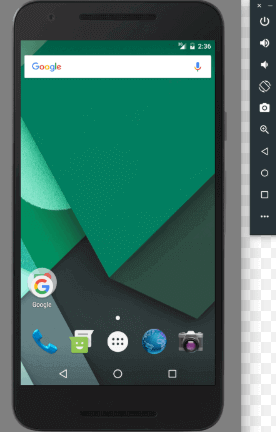 Testing Android applications on emulator are sometimes faster and easier than doing on a real device. For example, we can transfer data faster to the emulator than to a real device connected through USB. The Android emulator comes with predefined configurations for several Android phones, Wear OS, tablet, Android TV devices. Requirement and recommendationsThe Android emulator takes additional requirements beyond the basic system requirement for Android Studio. These requirements are given below:
Install the emulatorThe Android emulator is installed while installing the Android Studio. However some components of emulator may or may not be installed while installing Android Studio. To install the emulator component, select the Android Emulator component in the SDK Tools tab of the SDK Manager. Run an Android app on the EmulatorWe can run an Android app form the Android Studio project, or we can run an app which is installed on the Android Emulator as we run any app on a device. To start the Android Emulator and run an application in our project: 1. In Android Studio, we need to create an Android Virtual Device (AVD) that the emulator can use to install and run your app. To create a new AVD:- 1.1 Open the AVD Manager by clicking Tools > AVD Manager. 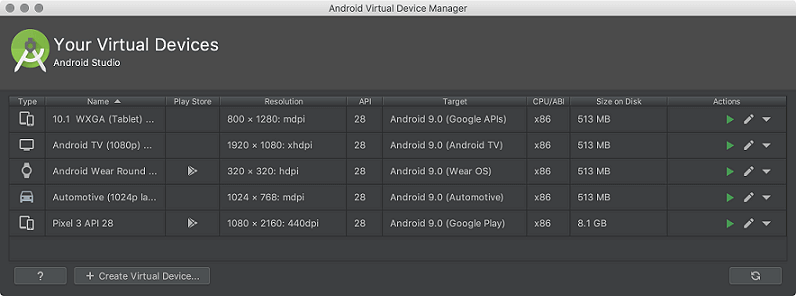 1.2 Click on Create Virtual Device, at the bottom of the AVD Manager dialog. Then Select Hardware page appears. 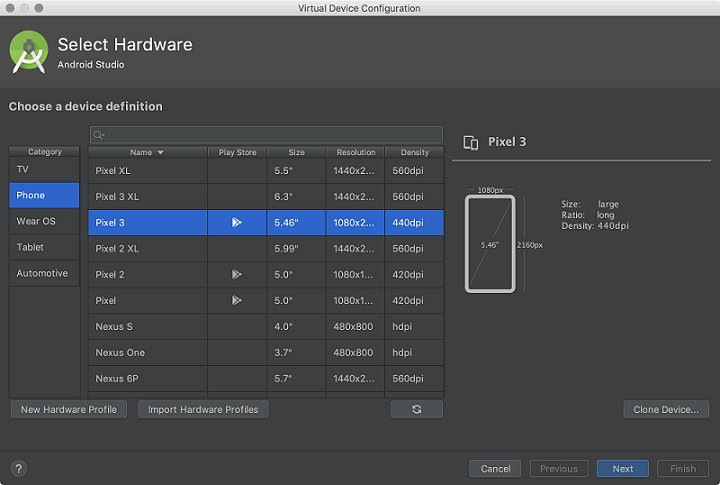 1.3 Select a hardware profile and then click Next. If we don?t see the hardware profile we want, then we can create or import a hardware profile. The System Image page appears. 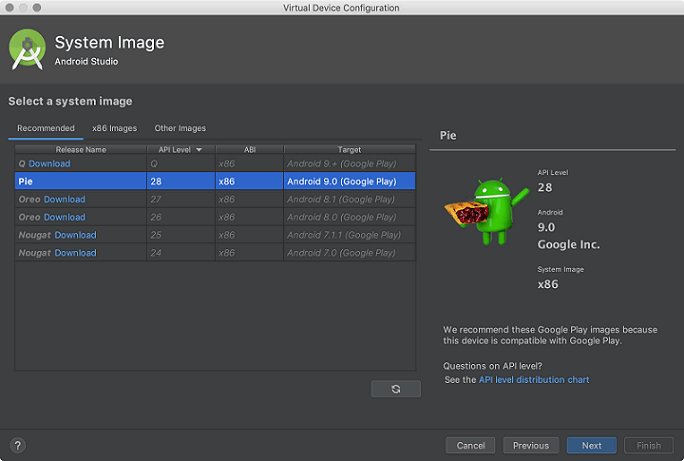 1.4 Select the system image for the particular API level and click Next. This leads to open a Verify Configuration page. 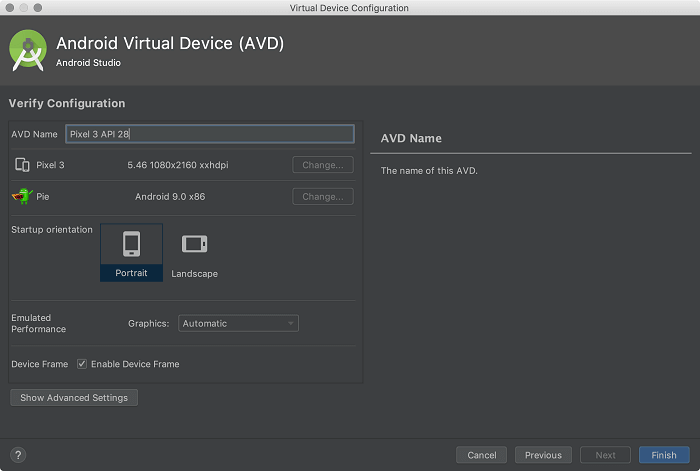 1.5 Change AVD properties if needed, and then click Finish. 2. In the toolbar, choose the AVD, which we want to run our app from the target device from the drop-down menu. 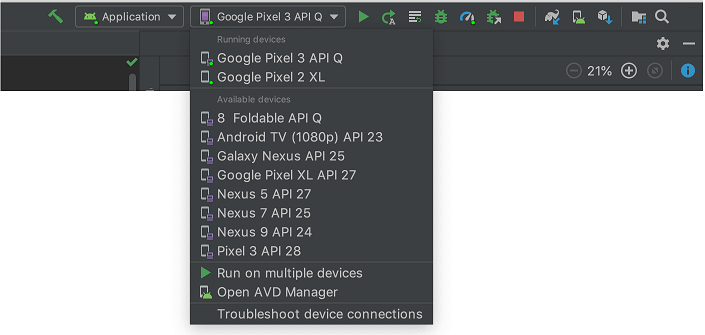 3. Click Run. Launch the Emulator without first running an appTo start the emulator:
While the emulator is running, we can run the Android Studio project and select the emulator as the target device. We can also drag an APKs file to install on an emulator, and then run them. Start the emulator from the command lineThe Android SDK includes the Android device emulator. Android emulator lets you develop and test out the application without using a physical device. Starting the emulatorUsing the emulator command, we will start an emulator. It is an alternative to run our project or start through the AVD Manager. Here is the basic command-line syntax for starting a virtual device: or For example, if we execute the emulator from Android Studio on a Mac, the default command line will be similar as follows: To display the list of AVD names, enter the following command: Run and stop an emulator, and clear dataFrom the Virtual Device page, we can perform the following operation on emulator: 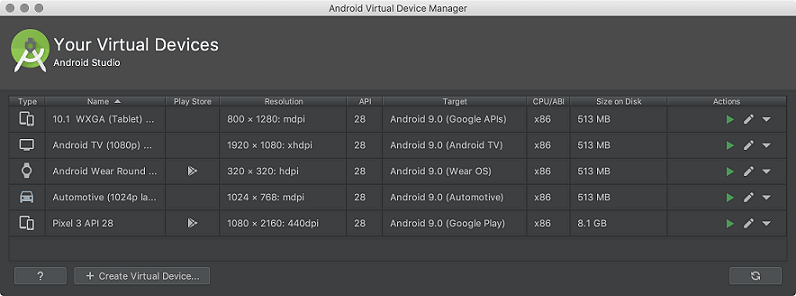
Next TopicInstalling Softwares For Android
|